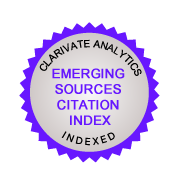Synthesis of Polyeugenol Sulfonate/Ag+ as an Antibacterial Coating on Cotton Fabric
Muhammad Cholid Djunaidi(1*), Dandy Andhika Fatriaji(2), Nesti Dwi Maharani(3), Khabibi Khabibi(4), Purbowatiningrum Ria Sarjono(5)
(1) Department of Chemistry, Faculty of Science and Mathematics, Diponegoro University, Jl. Prof. Soedharto SH, Tembalang, Semarang 50275, Indonesia
(2) Department of Chemistry, Faculty of Science and Mathematics, Diponegoro University, Jl. Prof. Soedharto SH, Tembalang, Semarang 50275, Indonesia
(3) Department of Chemistry, Faculty of Science and Mathematics, Diponegoro University, Jl. Prof. Soedharto SH, Tembalang, Semarang 50275, Indonesia
(4) Department of Chemistry, Faculty of Science and Mathematics, Diponegoro University, Jl. Prof. Soedharto SH, Tembalang, Semarang 50275, Indonesia
(5) Department of Chemistry, Faculty of Science and Mathematics, Diponegoro University, Jl. Prof. Soedharto SH, Tembalang, Semarang 50275, Indonesia
(*) Corresponding Author
Abstract
Cotton fabric is widely used in various applications, including the medical field, but its hygroscopic nature makes it prone to microbial contamination. Eugenol a natural phenolic compound extracted from cloves, exhibits potent antibacterial activity due to the ability of hydroxyl group to disrupt microbial membranes. However, its polymerized form, polyeugenol, shows a significantly slower antibacterial response, limiting its immediate effectiveness. In this study, we introduce sulfonate groups to increase the negative charge density of the polymer, potentially improving antibacterial activity. Additionally, Ag+ known for its strong antimicrobial effects, was impregnated. Further, synthesized polyeugenol sulfonate/Ag+ was applied as an antibacterial coating for cotton fabrics. This material could achieve moderate antibacterial activity with an inhibition zone reaching 7.86 and 8.04 mm against E. coli and S. aureus, respectively. These improvements in antibacterial activity are promoted to enhance the functionality of cotton fabrics in medical applications, where bacterial resistance is crucial for patient safety.
Keywords
Full Text:
Full Text PDFReferences
[1] Gulati, R., Sharma, S., and Sharma, R.K., 2022, Antimicrobial textile: Recent developments and functional perspective, Polym. Bull., 79 (8), 5747–5771.
[2] Szadkowski, B., Śliwka-Kaszyńska, M., and Marzec, A., 2024, Bioactive and biodegradable cotton fabrics produced via synergic effect of plant extracts and essential oils in chitosan coating system, Sci. Rep., 14 (1), 8530.
[3] Singh, P., Ali, S.W., and Kale, R.D., 2023, Antimicrobial nanomaterials as advanced coatings for self-sanitizing of textile clothing and personal protective equipment, ACS Omega, 8 (9), 8159–8171.
[4] Silva, M.V., de Lima, A.D.C.A., Silva, M.G., Caetano, V.F., de Andrade, M.F., da Silva, R.G.C., de Moraes Filho, L.E.P.T., de Lima Silva, I.D., and Vinhas, G.M., 2024, Clove essential oil and eugenol: A review of their significance and uses, Food Biosci., 62, 105112.
[5] Ulanowska, M., and Olas, B., 2021, Biological properties and prospects for the application of eugenol—A review, Int. J. Mol. Sci., 22 (7), 3671.
[6] Kowalewska, A., and Majewska-Smolarek, K., 2023, Eugenol-based polymeric materials—Antibacterial activity and applications, Antibiotics, 12 (11), 1570.
[7] Morales-Cerrada, R., Molina-Gutierrez, S., Lacroix-Desmazes, P., and Caillol, S., 2021, Eugenol, a promising building block for biobased polymers with cutting-edge properties, Biomacromolecules, 22 (9), 3625–3648.
[8] Adiwibawa Prasetya, N.B., Ngadiwiyana, N., Ismiyarto, I., and Sarjono, P.R., 2019, Synthesis of copolymer eugenol crosslinked with divinyl benzene and preliminary study on its antibacterial activity, IOP Conf. Ser.: Mater. Sci. Eng., 509 (1), 012102.
[9] Rahim, E.A., Istiqomah, N., Almilda, G., Ridhay, A., Sumarni, N.K., and Indriani, I., 2020, Antibacterial and antioxidant activities of polyeugenol with high molecular weight, Indones. J. Chem., 20 (3), 722–728.
[10] Bartel, M., Markowska, K., Strawski, M., Wolska, K., and Mazur, M., 2020, Silver-decorated gel-shell nanobeads: Physicochemical characterization and evaluation of antibacterial properties, Beilstein J. Nanotechnol., 11, 620–630.
[11] Zhong, L., Song, Y., and Zhou, S., 2021, Covalent grafting of sodium p-styrene sulfonate to stainless steel for antibacterial applications, Mater. Chem. Phys., 268, 124753.
[12] Casals, E., Gusta, M.F., Bastus, N., Rello, J., and Puntes, V., 2025, Silver nanoparticles and antibiotics: A promising synergistic approach to multidrug-resistant infections, Microorganisms, 13 (4), 952.
[13] Harun-Ur-Rashid, M., Foyez, T., Krishna, S.B.N., Poda, S., and Imran, A.B., 2025, Recent advances of silver nanoparticle-based polymer nanocomposites for biomedical applications, RSC Adv., 15 (11), 8480–8505.
[14] Djunaidi, M.C., Maharani, N.D., Pardoyo, P., and Raharjo, Y., 2024, Hollow fiber hemodialysis imprinted membrane based on eugenol for human blood filter, Indones. J. Chem., 24 (5), 1253–1267.
[15] Prasetya, N.B.A., Asiyah, A., Sarjono, P.R., Ngadiwiyana, N., and Ismiyarto, I., 2021, Synthesis of sulfonated poly-(eugenol divinylbenzene) nanosilver composite and its application as antibacterial compound of cotton fabric, J. Phys.: Conf. Ser., 1943 (1), 012183.
[16] Resende, D.B., Simões, L.A., Teixeira Fernandes, N.D.A., Luvizaro, L.B., Dias, M.V., Carvalho, D.T., Piccoli, R.H., Schwan, R.F., and Dias, D.R., 2023, Characterization of antimicrobial and antioxidant performance of dihydroeugenol and its glycoside incorporated into whey protein isolate films, Front. Food. Sci. Technol., 3, 1237638.
[17] Adiwibawa Prasetya, N.B., Ngadiwiyana, N., Ismiyarto, I., and Sarjono, P.R., 2019, Synthesis and study of antibacterial activity of polyeugenol, IOP Conf. Ser.: Mater. Sci. Eng., 509 (1), 012101.
[18] Zaman, M.W., Han, J., and Zhang, X., 2022, Evaluating wettability of geotextiles with contact angles, Geotext. Geomembr., 50 (4), 825–833.
[19] Xie, Z., Zhang, P., Zhang, Z., Chen, C., and Wang, X., 2024, The choice of antimicrobial polymers: Hydrophilic or hydrophobic?, Chin. Chem. Lett., 35 (9), 109768.
[20] Møllebjerg, A., Palmén, L.G., Gori, K., and Meyer, R.L., 2021, The bacterial life cycle in textiles is governed by fiber hydrophobicity, Microbiol. Spectrum, 9 (2), e01185-21.
Article Metrics
Copyright (c) 2025 Indonesian Journal of Chemistry

This work is licensed under a Creative Commons Attribution-NonCommercial-NoDerivatives 4.0 International License.
Indonesian Journal of Chemistry (ISSN 1411-9420 /e-ISSN 2460-1578) - Chemistry Department, Universitas Gadjah Mada, Indonesia.












